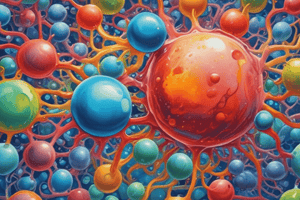Podcast
Questions and Answers
Which principle describes the use of energy from the environment by living organisms?
Which principle describes the use of energy from the environment by living organisms?
- Metabolism (correct)
- Dynamic steady state
- Self-replication
- Evolution
What does cellular self-replication involve?
What does cellular self-replication involve?
- Maintaining homeostasis
- Utilizing external energy sources
- Assembly of supramolecular structures
- Chemical information stored in the genome (correct)
How do biochemists apply their knowledge in the field of medicine?
How do biochemists apply their knowledge in the field of medicine?
- By constructing industrial bioreactors
- By developing pesticides
- Through analyzing blood tests (correct)
- In studying environmental pollutants
Which of the following is NOT a feature that defines a living organism?
Which of the following is NOT a feature that defines a living organism?
Biochemistry interconnects which of the following areas?
Biochemistry interconnects which of the following areas?
Which statement accurately describes the dynamic state of living organisms?
Which statement accurately describes the dynamic state of living organisms?
What role do carbon-based metabolites play in living organisms?
What role do carbon-based metabolites play in living organisms?
What is one of the biochemical applications in agriculture?
What is one of the biochemical applications in agriculture?
Which bioelements make up more than 99% of the mass of most cells?
Which bioelements make up more than 99% of the mass of most cells?
What is the characteristic bond formed when atoms share electrons?
What is the characteristic bond formed when atoms share electrons?
What role do secondary bioelements primarily play in organisms?
What role do secondary bioelements primarily play in organisms?
Which of the following statements about oligoelements is true?
Which of the following statements about oligoelements is true?
Which of the following levels of organization comes directly after the molecular level?
Which of the following levels of organization comes directly after the molecular level?
Electronegativity is defined as:
Electronegativity is defined as:
Which type of bond is characterized by the transfer of electrons?
Which type of bond is characterized by the transfer of electrons?
What defines a molecule?
What defines a molecule?
Which of the following bioelements is classified as an oligoelement?
Which of the following bioelements is classified as an oligoelement?
Which structures represent the hierarchy of biological organization in living things?
Which structures represent the hierarchy of biological organization in living things?
Flashcards
Biochemistry definition
Biochemistry definition
The study of the structures, mechanisms, and chemical processes in living organisms.
Biochemistry impact
Biochemistry impact
Biochemistry affects medicine, agriculture, industry, and the environment.
Living organism features
Living organism features
Characteristics that define life, including highly organized structure, energy use, self-replication, and evolution.
Fundamental unit of life
Fundamental unit of life
Signup and view all the flashcards
Dynamic steady state
Dynamic steady state
Signup and view all the flashcards
Self-replication and self-assembly
Self-replication and self-assembly
Signup and view all the flashcards
Biological macromolecules
Biological macromolecules
Signup and view all the flashcards
Metabolism (anabolic/catabolic)
Metabolism (anabolic/catabolic)
Signup and view all the flashcards
Bioelements
Bioelements
Signup and view all the flashcards
Primary Bioelements
Primary Bioelements
Signup and view all the flashcards
Secondary Bioelements
Secondary Bioelements
Signup and view all the flashcards
Oligoelements
Oligoelements
Signup and view all the flashcards
Atomic level
Atomic level
Signup and view all the flashcards
Covalent Bond
Covalent Bond
Signup and view all the flashcards
Molecule
Molecule
Signup and view all the flashcards
Electronegativity
Electronegativity
Signup and view all the flashcards
Levels of Organization
Levels of Organization
Signup and view all the flashcards
Chemical Bonding
Chemical Bonding
Signup and view all the flashcards
Study Notes
Biochemistry Introduction
- Biochemistry is a molecular description of the structures, mechanisms, and chemical processes of living things.
- It describes the shared structures, mechanisms, and chemical processes in all organisms.
- Biochemists use physical and chemical principles to explain biology at the molecular level.
Impact of Biochemistry
- Biochemistry influences medicine through blood tests (e.g., glucose, cholesterol) and drug development.
- It impacts agriculture by analyzing how fertilizers and pesticides interact with crops at the cellular level.
- It's crucial in industrial applications such as food science and biotechnology.
- Biochemistry is used to understand how pollutants behave in the body.
Principle Areas of Biochemistry
- Biochemistry connects nutrition, metabolism, and genetics to health and disease.
- Structure and function of biological macromolecules are vital for maintaining an internal environment. The body consumes and manages the food & water, taking in oxygen from the air.
- Metabolism includes anabolic and catabolic processes to utilize energy for work and regulate body temperature, expelling CO2, water, and nitrogenous waste.
- Molecular genetics describes how life replicates and regulates protein synthesis.
Features That Define a Living Organism
- Cells: The fundamental units of life.
- Carbon-based Molecules: Cells use a limited set of carbon-based molecules to create complex structures and information storage.
- Dynamic Steady State: Living organisms constantly adjust to maintain an internal balance, but are never in true equilibrium.
- Self-replication and self-assembly: Cells replicate and maintain structures through encoded information.
- Evolution: Organisms change over time through gradual evolution.
- Organization: Living organisms exhibit high levels of organization at various structural levels (atomic, molecular, cellular, tissue, organ, organism, population, ecosystem, and biosphere).
- Energy Extraction and Transformation: Organisms extract, transform, and use energy from the environment to sustain life.
Atomic Level
- Bioelements: Elements essential for life, primarily carbon, hydrogen, oxygen, and nitrogen. These make up more than 99% of the majority of most cell mass. Carbon, hydrogen, oxygen and nitrogen have unique bonding abilities giving rise to covalent bonds, allowing for the variety of organic molecules and organisms.
- Elements in the periodic table.
- Bulk elements are the most prevalent elements in an organism. Some important bulk elements include: Carbon (C), Hydrogen (H), Oxygen (O), Nitrogen (N), Phosphorous (P), Sulfur (S), Potassium (K), Sodium (Na), Calcium (Ca), and Magnesium (Mg).
- Trace elements are present in much smaller proportions. Crucial trace elements include: Iron (Fe), Zinc (Zn), Copper (Cu), Iodine (I), Manganese (Mn), Molybdenum (Mo), Chromium (Cr).
- Subatomic Particles, Electrons, Protons, and neutrons. Electrons carry a negative charge, whilst protons carry a positive one. Neutrons are electrically neutral.
- Electronegativity: Some elements have a greater affinity for electrons, leading to polar covalent bonds. Important electronegative elements in molecules are oxygen (O) and nitrogen (N).
Molecular Level
-
Molecules: Groups of atoms bonded together, forming the fundamental units in chemical compounds and taking part in chemical reactions.
-
Chemical bonding: Interactions between atoms forming bonds in molecules. Types of bonds include:
- Metallic Bond: A bond formed by the sharing of electrons between metal atoms.
- Ionic bond: A bond formed by the electrostatic attraction between positive and negative ions (atoms that have lost or gained electrons).
- Covalent bond: A bond formed by the sharing of electrons between nonmetal atoms. Can be Polar or Nonpolar
- Polar Covalent bonds: Electrons are shared unequally because of differences in electronegativity between atoms. Creates areas of partially positive and partially negative charge, driving many intermolecular interactions and creating special properties like water.
-
Biomolecules: Molecules essential to life categories include:
- Inorganic Biomolecules: Simple structures, final products of metabolism, and commonly present in the environment (e.g., water, gases, salts).
- Organic Biomolecules: Carbon-based, complex structures, and found only in living organisms (e.g., carbohydrates, lipids, proteins, nucleic acids)
-
Metabolism: The complex biochemical reactions in a biological system involving the creation and breakdown of complex molecules. - Anabolism: Building complex molecules from simpler ones. Energy is required to drive anabolic reactions forward. - Catabolism: Breakdown of complex molecules into simpler ones. Releases energy, often used by the organisms in anabolic or other cellular tasks.
-
Monomers and Polymers: Monomers are small molecules and polymers are large molecules (macromolecules) formed from repeating monomers.
-
Macromolecules: Large biological molecules, including proteins, nucleic acids, carbohydrates, and lipids.
-
Intermediates metabolites: Small molecules that are involved in biochemical reactions.
-
Steady state: Living organisms maintain a dynamic equilibrium in the steady state where overall concentrations of molecules remain nearly consistent because of the balanced synthesis and breakdown rates, even as molecules or material are constantly flowing in and out of this system.
Studying That Suits You
Use AI to generate personalized quizzes and flashcards to suit your learning preferences.






